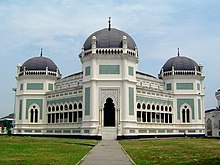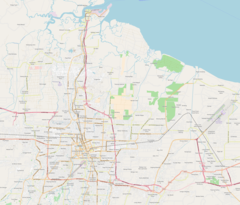
Islamic architecture comprises the architectural styles of buildings associated with Islam. It encompasses both secular and religious styles from the early history of Islam to the present day. The Islamic world encompasses a wide geographic area historically ranging from western Africa and Europe to eastern Asia. Certain commonalities are shared by Islamic architectural styles across all these regions, but over time different regions developed their own styles according to local materials and techniques, local dynasties and patrons, different regional centers of artistic production, and sometimes different religious affiliations.

Maimoon Palace or Maimun Palace is an istana of the Sultanate of Deli and a well-known landmark in Medan, the capital city of Northern Sumatra, Indonesia. Today, it serves as a museum. The name is the Arabic word for "blessing".

Indo-Islamic architecture is the architecture of the Indian subcontinent produced by and for Islamic patrons and purposes. Despite an initial Arab presence in Sindh, the development of Indo-Islamic architecture began in earnest with the establishment of Delhi as the capital of the Ghurid dynasty in 1193. Succeeding the Ghurids was the Delhi Sultanate, a series of Central Asian dynasties that consolidated much of North, East, and Central India, and later by the Mughal Empire during the early 16th century. Both of these dynasties introduced Islamic architecture and art styles from West Asia into the Indian subcontinent.
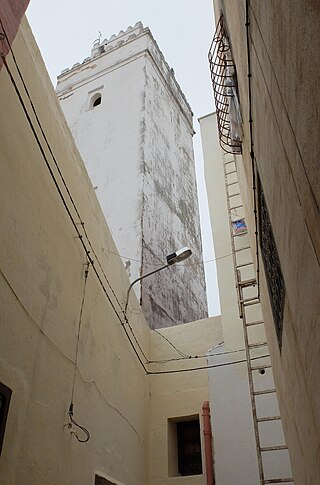
The Great Mosque of Taza is the most important religious building in the historic medina of Taza, Morocco. Founded in the 12th century, it is the oldest surviving example of Almohad architecture, although it was expanded by the Marinids in the late 13th century.

The Sultanate of Deli was a 1,820 km2 Malay state in east Sumatra founded in 1632 when a commander of the Aceh Sultanate, Gocah Pahlawan, conquered the area during the reign of Iskandar Muda. A tributary kingdom from 1630 it was controlled by various sultanates until 1814, when it became independent and broke away from the Sultanate of Siak.

Baiturrahman Grand Mosque is a mosque located in Banda Aceh, Aceh, Indonesia. The Baiturrahman Grand Mosque is a symbol of religion, culture, spirit, strength, struggle, and nationalism of the Acehnese people. The mosque is a landmark in Banda Aceh and has survived the 2004 Indian Ocean earthquake and tsunami.
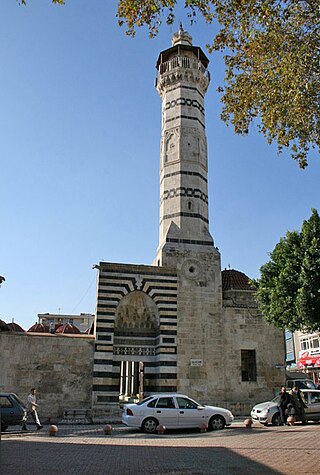
The Great Mosque of Adana, also known as the Ramazanoglu Mosque, is a 16th-century mosque in Adana, Turkey. It forms part of a complex (külliye) that includes a madrasah and a mausoleum (türbe). The complex is on Kızılay street, next to the Ramazanoğlu Hall.

Sultan Ghari was the first Islamic Mausoleum (tomb) built in 1231 AD for Prince Nasiruddin Mahmud, eldest son of Iltumish, in the "funerary landscape of Delhi" in the Nangal Dewat Forest, Near Nangal Dewat Vasant Kunj).

Moth ki Mosque is a heritage building located in Delhi, and was built in 1505 by Wazir Miya Bhoiya, Prime Minister during the reign of Sikander Lodi (1489–1517) of the Lodi dynasty. It was a new type of mosque developed by the Lodis in the fourth city of the medieval Delhi of the Delhi Sultanate. The name of the mosque literally translated into English language means ‘Lentil Mosque’ and this name tag ‘Lentil’ has an interesting legend. This mosque was considered a beautiful Dome (Gumbad) structure of the period.

The Ganting Grand Mosque is a Sunni mosque located in Ganting, Padang, West Sumatra, Indonesia. Construction began in 1805, making it the oldest in Padang and one of the oldest in Indonesia. It is a Cultural Property of Indonesia.

Sultan Ma'mun Al Rashid Perkasa Alam Shah was the 9th king of the Sultanate of Deli. His title after his death was Marhum Makmur.

Sultan of Ternate Mosque, also known as the Old Mosque of Ternate, is an old mosque in Ternate City, Indonesia. It is the largest mosque in the city and the royal mosque of the Ternate Sultanate.

The Grand Mosque of Bandung, previously known as the Great Mosque of Bandung, is a mosque in Bandung, the a provincial capital of West Java, Indonesia. The mosque received the status of provincial mosque in West Java Province in 2004. It is located on the east side of the alun-alun of Bandung.

Al-Osmani Mosque is a mosque in Medan, North Sumatra, Indonesia. The mosque is also known as Labuhan mosque because it is located in the district of Medan Labuhan. The mosque is located on the K.L. Yos Sudarso road, subdistrict of Pekan Labuhan, about 20 kilometers north of the city of Medan. In front of this mosque there is a school, named YASPI School, and not far from the mosque there is a Chinese temple named Pekong Lima, and in front of the temple there is a path that leads to Labuhan market. The mosque is the oldest in the city of Medan.
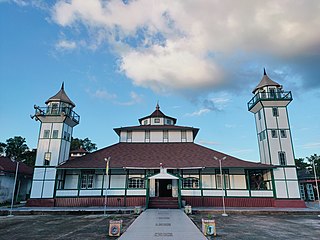
Jami Mosque of Sintang also known as Sultan Nata Mosque is a mosque located in Sintang, West Kalimantan, Indonesia. The mosque is located within the complex of Istana al-Mukarrammah, the main palace of the Sultanate of Sintang, a kingdom in Sintang which existed since the 13th-century.

Mosque architecture in Indonesia refers to the architectural traditions of mosques built in the archipelago of Indonesia. Initial forms of the mosque, for example, were predominantly built in the vernacular Indonesian architectural style mixed with Hindu, Buddhist or Chinese architectural elements, and notably didn't equip orthodox form of Islamic architectural elements such as dome and minaret. Vernacular architectural style varies depending on the island and region.

Jami Mosque of Pontianak, also known as Sultan Syarif Abdurrahman Mosque, is the oldest mosque of Pontianak, in Kalimantan, Indonesia. The large wooden mosque, together with the royal palace of Kraton Kadriyah, was among the first buildings constructed in the city following the establishment of Pontianak in 1771.

Grand Mosque of Kubang Putih is an early 19th-century mosque located in the town of Kubang Putiah, West Sumatra, Indonesia. The mosque is designated as a cultural heritage object along with several other old mosques in West Sumatra, such as Bingkudu Mosque in Agam, Rao Rao Mosque in Tanah Datar, and the Ganting Grand Mosque in Padang.

The Kasbah Mosque, also known as the Moulay al-Yazid Mosque, is a historic mosque in Marrakesh, Morocco. It was originally built by the Almohad ruler Yaqub al-Mansur in 1185–1190 CE. It is located in the Kasbah district, the city's former citadel, near the site of its historic royal palaces. Along with the Kutubiyya Mosque, it is one of the most important historic mosques in Marrakesh.

Hilal Khan Ghazi Mosque is a monumental mosque located at Dholka, Gujarat, India. It is considered as the oldest mosque at Dholka. It was erected by Hilal Khan Ghazi, who was a general of the Tughlaqs, in 1333 during the period of Tughlaqs. The mosque is considered one of the most significant mosques of that historical period in its architectural style and artistic decorations.
